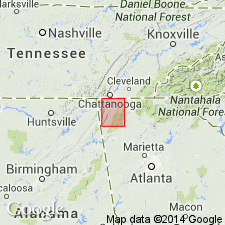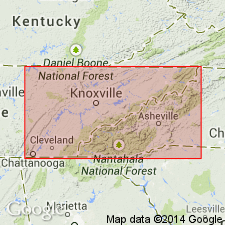
- Usage in publication:
-
- Apison shale*
- Modifications:
-
- Original reference
- Dominant lithology:
-
- Shale
- AAPG geologic province:
-
- Appalachian basin
Summary:
(Ringgold, Kingston, and Chattanooga folios). Apison shale. Brightly colored, slightly sandy or clayey shales, banded in red, purple, green, and yellow colors. A bed of gray siliceous limestone [†Beaver limestone] sometimes occurs between this and overlying Rome formation. Thickness of formation more than 1,000 feet. Oldest formation in region. Age is Early Cambrian.
Source: US geologic names lexicon (USGS Bull. 896, p. 61).

- Usage in publication:
-
- Apison shale*
- Modifications:
-
- Overview
- AAPG geologic province:
-
- Appalachian basin (Eastern Overthrust area)
Summary:
Apison shale. According to C.E. Resser (personal commun. May 1936) the Apison shale is part of Rome formation, and so-called Beaver limestone of Knoxville folio is a limestone lentil in Rome formation. Age is Early Cambrian.
Named from exposures at Apison, James Co. [now Hamilton Co.], eastern TN. Extends into western NC, and northwestern GA.
Source: US geologic names lexicon (USGS Bull. 896, p. 61).

- Usage in publication:
-
- Apison shale member
- Modifications:
-
- Revised
- AAPG geologic province:
-
- Appalachian basin
Summary:
Pg. 44; pt. 1, pl. 12. Apison shale member of Rome formation. Variegated shale. Mapped as a basal member of Rome formation. Underlies an unnamed sandstone-bearing member of Rome. Age is Early Cambrian.
Source: US geologic names lexicon (USGS Bull. 1200, p. 117).
For more information, please contact Nancy Stamm, Geologic Names Committee Secretary.
Asterisk (*) indicates published by U.S. Geological Survey authors.
"No current usage" (†) implies that a name has been abandoned or has fallen into disuse. Former usage and, if known, replacement name given in parentheses ( ).
Slash (/) indicates name conflicts with nomenclatural guidelines (CSN, 1933; ACSN, 1961, 1970; NACSN, 1983, 2005, 2021). May be explained within brackets ([ ]).

